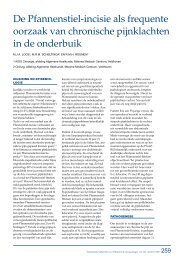ABSTRACTBackgroundRoutine <strong>inguinal</strong> hernia repair results in severe persisting <strong>pain</strong> with occupational disabilityin 1-2% <strong>of</strong> the patients. Resumption <strong>of</strong> work after <strong>pain</strong> treatment can be regardedas an important outcome measure. Aim <strong>of</strong> this study was to evaluate the effect <strong>of</strong>surgical and non-surgical treatment on resolving occupational disability due to postherniorrhaphy<strong>inguinal</strong> neuralgia.Study designFirst, relevant studies on operative and non-operative treatment for postherniorrhaphy<strong>inguinal</strong> neuralgia were reviewed with respect to effect on occupational disability.Second, a recently published registry <strong>of</strong> patients with postherniorrhaphy neuralgiatreated by operative neurectomy was analyzed for occupational disability. Patients werecontacted by telephone and given a set <strong>of</strong> predetermined questions concerningpre- and postoperative disability. Finally, a cost-benefit analysis for occupational disabilityand neurectomy was made.ResultsOnly 4 out <strong>of</strong> 23 studies on neurectomy for <strong>inguinal</strong> neuralgia reported on occupationaldisability as a secondary outcome measure. Some 56 to 100% <strong>of</strong> the patients couldresume their occupational obligations after <strong>pain</strong> treatment. Studies on non-surgical<strong>pain</strong> treatment and occupational disability were unavailable. Forty-eight patientspreviously treated by neurectomy were analyzed for occupational disability. Severe <strong>pain</strong>disabled 13 patients and a neurectomy resulted in total recovery in 7 <strong>of</strong> them (7/13, 54%).Finally, an estimating cost-benefit analysis showed that effective <strong>pain</strong> treatment such asa tailored neurectomy can save a minimum <strong>of</strong> € 1.8 million <strong>of</strong> workers’ compensationalcosts in The Netherlands yearly.ConclusionsTailored neurectomy is an effective treatment for occupational disability due to postherniorrhaphy<strong>inguinal</strong> neuralgia in some patients. A successful neurectomy greatlyreduces workers’ compensational costs and may have substantial financial consequencesworldwide.124 Chapter 10Occupational disability due to <strong>chronic</strong> postherniorrhaphy neuralgia: a plea for tailored neurectomy 125
INTRODUCTIONIn the Netherlands, approximately 28.000 individuals <strong>of</strong> 18 years or older are yearlydiagnosed with an <strong>inguinal</strong> hernia whereas some 22.000 patients receive operativecorrection (http://www.primant.nl). Severe postherniorrhaphy <strong>pain</strong> may develop in upto 2% (n=440) <strong>of</strong> this population 1-3 . Knowledge <strong>of</strong> the pathophysiology <strong>of</strong> <strong>chronic</strong> postherniorrhaphy<strong>pain</strong> is increasing. The <strong>pain</strong> is frequently neuropathic due to entrapmentor neuroma formation <strong>of</strong> the <strong>inguinal</strong> nerves (Iliohypogastric, Ilio<strong>inguinal</strong>, genital branch<strong>of</strong> the genit<strong>of</strong>emoral nerve) 4 . Other patients suffer from nociceptive <strong>pain</strong> includingperiostal inflammation due to sutures, compressed and displaced prosthetic materialor fibrosis causing mechanical discomfort 4 .There are non-operative or operative treatment options. It has been estimated thatsome 1% <strong>of</strong> all patients after open herniorrhaphy require a multidisciplinary non-operativetreatment regimen for <strong>chronic</strong> <strong>pain</strong> in a specialized <strong>pain</strong> clinic 5 . Such treatmentmodalities include peripheral nerve blocks 6,7 , prescription <strong>of</strong> neuropathic agents (e.g.amitriptylin or gabapentin), Transcutaneous Electric Nerve Stimulation (TENS), physiotherapy,acupuncture, peripheral neurostimulation using implantable devices 8 or PulsedRadio Frequency (PRF). In contrast to the many non-surgical <strong>pain</strong> strategies 6-11 , there isa paucity <strong>of</strong> data on treatment results. However, the body <strong>of</strong> data on surgery for severepostherniorrhaphy <strong>pain</strong> is quickly expanding. Several studies on operative treatmentmodalities such as neurectomy, cryoanalgesic ablation or removal <strong>of</strong> mesh or tackersdemonstrate long-term <strong>pain</strong> reduction in 60-80% <strong>of</strong> the patients 12-19 . At groin exploration<strong>inguinal</strong> nerves may be found ‘entrapped’ by suture material or encased in fibrosis 4 .Moreover, a traumatic neuroma may also be identified. Traumatized nerves are removedas proximally and distally as possible while proximal nerve ends are buried in healthymuscular tissue 18 . Bulky mesh material may require resection as well. The number <strong>of</strong>nerves requiring resection remains under debate. Some authors advocate a triple neurectomyremoving all three <strong>inguinal</strong> nerves at once whereas others favour a selectiveneurectomy <strong>of</strong> the affected nerve (‘tailored neurectomy’) 18 .Most studies use long-term <strong>pain</strong> resolution as primary treatment outcome measure.However, work resumption is considered important for the patient’s well-being as wellas from an economical point <strong>of</strong> view. As young males are particularly prone to <strong>chronic</strong><strong>pain</strong> development, the socio-financial consequences <strong>of</strong> severe postherniorrhaphy <strong>pain</strong>are thought considerable as most <strong>of</strong> these young patients will file for workers’ compensationfor a substantial number <strong>of</strong> years if not for the rest <strong>of</strong> their working lifes 2,20 .Moreover, these relatively young disabled patients are thought to demonstrate increasedhealth care consumption thus adding to the society’s loss <strong>of</strong> financial resources 21 .The present study aimed at reviewing the present body <strong>of</strong> literature on surgical treatment(neurectomy) and non-surgical treatment on overcoming occupational disabilitydue to postherniorrhaphy <strong>inguinal</strong> neuralgia. Moreover, the results <strong>of</strong> recently publishedstudy on tailored neurectomy were reviewed with respect to occupational disability.A cost-benefit analysis for occupational disability and neurectomy was performed.METHODSReview <strong>of</strong> the literatureDatabases including Medline, Embase, and Pubmed were searched for relevant studieson treatment options for <strong>chronic</strong> postherniorrhaphy <strong>inguinal</strong> <strong>pain</strong> and the effect onoccupational disability. A search using the term Pain was combined with the followingentries: Inguinal, Hernia, Neuralgia, Neurectomy, Treatment, Workers’ compensation,Occupational disability, Nerve blocks, PRF, and TENS. There was no limitation in publicationdate and only English language articles were extracted. A study was excluded ifreferences to occupational disability or workers’ compensation were absent. Referencelists <strong>of</strong> selected articles were cross-checked for pertinent literature. The following datawere used for analysis: operative or non-operative treatment, number <strong>of</strong> includedpatients, type <strong>of</strong> study design, treatment, length <strong>of</strong> follow-up, and effect on occupationaldisability.Tailored neurectomyOur group <strong>of</strong> investigators recently published on the long-term ‘tailored neurectomy’outcome for <strong>inguinal</strong> neuralgia after hernioplasty 18 . As our experience with treatingthese patients grew, we started to appreciate the potential detrimental impact <strong>of</strong> this<strong>chronic</strong> <strong>pain</strong> state on occupational capabilities and consequently the possible curativeeffect <strong>of</strong> a neurectomy. Therefore, this population was again analyzed aimed at studyingthe effect <strong>of</strong> the surgical neurectomy on occupational disability. All patients were contactedby telephone and received a set <strong>of</strong> questions regarding working status prior tothe initial hernia repair, (if applicable) type <strong>of</strong> work (light or heavy physical work), onset<strong>of</strong> postherniorrhaphy <strong>pain</strong> and occupational disability and its degree (partial/ total),result <strong>of</strong> neurectomy on occupational disability and whether the previous work couldbe resumed (table 1).1 What was your occupational status before the <strong>inguinal</strong> hernia repair?2 Did your occupational status alter due to <strong>pain</strong> complaints after the <strong>inguinal</strong> herniorrhaphy?3 Did you become occupationally disabled?4 What is the degree <strong>of</strong> your occupational disability? Partial/ complete?5 Did you resume your work after operative treatment for the postherniorrhaphy <strong>pain</strong> <strong>syndromes</strong>?Table 1 Questions regarding occupational disability.126 Chapter 9Occupational disability due to <strong>chronic</strong> postherniorrhaphy neuralgia: a plea for tailored neurectomy 127





